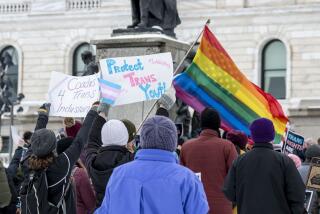One Journey of Self-Discovery in a Homophobic World
- Share via
SURVIVING MADNESS: A THERAPIST’S OWN STORY
By Betty Berzon
University of Wisconsin Press
242 pages, $27.95 (illustrated)
*
In a world filled with dangers of all kinds, from terrorism, global warming and overpopulation to economic injustice, pension-fund raiders, serial killers and drunk drivers, it is hard to understand why so many people feel threatened by the mere existence of men and women who happen to be sexually attracted to members of their own gender.
Yet homophobia is an attitude so tenaciously entrenched, for a long time it has afflicted homosexuals as well. Few people know this better than Los Angeles-based psychotherapist, author and gay activist Betty Berzon, who tells the story of her own experience in her dramatic, action-packed autobiography, “Surviving Madness.”
Born in St. Louis in 1928, Berzon came of age in a world where she had no idea what to make of her feelings. She dated boys, but, oddly, had no fantasies about them. Instead, in her daydreams, she imagined herself as “Clark Gable or Errol Flynn sweeping some beauty off her feet....I’d heard of homosexuality ... heard that it was a sickness, and I wondered if I had caught it.” A bright, outgoing girl with no trouble attracting boys, she was frightened by her overpoweringly sexual feelings for women.
Berzon alternated between two approaches. She went ahead with a “normal” life of dating--and later, having affairs with--men. And she began to investigate the lesbian scene.
Neither the “normal” world of dating and mating, nor the intense, closeted world of 1950s lesbians felt right to her. In her 20s, Berzon, by now a successful Los Angeles bookseller, suffered a mental breakdown following the breakup of her relationship with a female lover. It was during her sojourn as a patient at a psychiatric hospital that two people--a fellow patient and a doctor--suggested her gift for talking to people and drawing them out might make her a good therapist.
Berzon plunged into her new career with energy and zest, becoming involved in all the latest trends, from encounter groups and the Human Potential Movement to (heterosexual) orgies. But her 40th birthday in 1968 marked a turning point when she realized that she was no longer content to evade her sexual orientation. The rest, as they say, was history--in this case, part of the history of the gay rights movement, as Berzon became involved in a multitude of activities, from the establishment of Los Angeles’s Gay and Lesbian Community Services Center to the successful campaign to persuade the psychiatric and psychology professions to drop homosexuality from their list of mental disorders. Along the way, she fought her own internalized homophobia and anxieties about romantic commitment, finding true love at last with her permanent partner, Teresa DeCrescenzo.
Berzon’s experiences as a “gay affirmative” therapist, a political activist and a woman committed to a permanent partnership were reflected in the popular advice books she went on to write. “Setting Them Straight” provided solid suggestions as to what gay and gay-sympathetic people could do when confronted with homophobic remarks and attitudes. “Permanent Partners” and “The Intimacy Dance” offered sound advice on building long-term relationships. Too often, Berzon believes, gays and lesbians have “internalized” society’s dismissive attitudes toward their partnerships: “can’t work, won’t last, don’t count.” “Our relationships,” she insists, “can work and last, and they absolutely do count just as much as we want them to.”
Although not an advice book, Berzon’s memoir has the same pragmatic, can-do approach, and it is instructive to see how her ideas grew out of the difficulties she experienced. Having found strength in the sense of “rage” that animated the post-Stonewall gay rights movement, Berzon was shocked to find some of that “rage” being turned against her and her colleagues, when a cadre of disaffected staffers at the Gay Community Services Center accused the project directors of mismanagement: “CLOSE IT DOWN OR WE’LL BURN IT DOWN!” they screamed helpfully.
“What insanity was this?” wondered Berzon. “Friend against friend? How gullible people can be, allowing themselves to be misled into villain-victim scenarios, manipulated into violent protests with little or no evidence that a wrong has been done to them.” Berzon notes how the rage that feeds legitimate protest movements can become a permanent attitude, turning former allies into enemies and leading to “the circular firing squad” that has been such a prevalent feature of revolutions ever since the French one.
Looking back on the psychiatric help she received in the 1950s, Berzon feels gratitude rather than rancor toward the doctor who saved her life but who also reassured her that she was not homosexual: “Did Fred Feldman do me a disservice by reinforcing my own homophobia? Given the zeitgeist of the 1950s, I don’t see how he could have done anything different....I have never wavered in my certainty that his only motive was to help me. I’m just sorry he didn’t stick around to see the world change. I truly believe he would have changed with it. In later years, I wanted to go back to Dr. Feldman for two reasons: to fix his thinking about ... gay people and to pay him something for the years he saw me without charge. I was distressed to learn he had died before I could reconnect with him. I still believe I owe him my life.”
And a useful and fascinating one it turned out to be!
More to Read
Sign up for our Book Club newsletter
Get the latest news, events and more from the Los Angeles Times Book Club, and help us get L.A. reading and talking.
You may occasionally receive promotional content from the Los Angeles Times.







